Hydrophobic Effect of Soil Stabilization for a Sustainable Subgrade Soil Improvement
Abstract
:1. Introduction
2. Materials and Methods
2.1. Subsection
2.1.1. Soils
2.1.2. HC
2.1.3. OPC
2.2. Method
2.2.1. Mix Design
2.2.2. Soil Sample Preparation
2.2.3. Experimental Procedure
3. Results
3.1. Characteristics of Strength Development Analysis
Influence of Caltite Content and Cement on Soil Density
3.2. Influence of Caltite Content and Cement on UCS
3.3. Influence of Caltite Content and Cement on FS
3.4. Influence of Caltite Content and Cement on Porosity and Absorption
3.5. Influence of Caltite and Cement on CBR
4. Discussion of the Effect of HC with Cement on Treated Soil
4.1. Microstructural Analysis
4.1.1. SEM Analysis
4.1.2. EDX Spectroscopy
5. Conclusions
- The addition of caltite to soil treated for cement stabilization increases the UCS, shear strength, FS, and CBR values in the two chemical agents.
- Adding caltite to cement-treated soil improves its post-peak behavior, particularly during the early curing stages (the 7th day). In this case, the best soil-additive reaction occurred.
- Stabilizing the soil with reinforced HC resulted in a greater strength than cement alone, regardless of the curing period. This trend is most noticeable after the 7, 28, and 90 days of curing periods.
- After 7 and 28 days of curing, the soil treated with caltite and cement showed a significant pozzolanic reaction compared to the soil treated with cement alone or untreated lateritic soil.
- The interfacial interlocking observed in the soil treated with HC and cement-treated soil demonstrated effective bonds compared to that with untreated soil. However, the mixture of HC and cement reduced porosity, voids, and cracking in the soil sample compared with the cement soil sample.
- SEM and EDX analyses revealed that the reaction that occurs in the soil treated with caltite and cement mixture resulted in a denser soil. By contrast, the reaction that occurs in the soil alone tends to result in the binding of soil particles and the strengthening of soil.
- Finally, the SEM analysis proved that adding caltite to cement soil led to new globular polymer bonding compounds. These compounds essentially filled the soil cracks and porous voids. Consequently, the soil density improved with greater strength and more effective void filling.
Author Contributions
Funding
Institutional Review Board Statement
Informed Consent Statement
Data Availability Statement
Acknowledgments
Conflicts of Interest
References
- Behnood, A. Soil and Clay Stabilization with Calcium- and Non-Calcium-Based Additives: A State-of-the-Art Review of Challenges, Approaches and Techniques. Transp. Geotech. 2018, 17, 14–32. [Google Scholar] [CrossRef]
- Rosales, J.; Agrela, F.; Marcobal, J.R.; Diaz-López, J.L.; Cuenca-Moyano, G.M.; Caballero, Á.; Cabrera, M. Use of Nanomaterials in the Stabilization of Expansive Soils into a Road Real-Scale Application. Materials 2020, 13, 3058. [Google Scholar] [CrossRef] [PubMed]
- Ridtirud, C.; Leekongbub, S.; Chindaprasirt, P. Compressive Strength of Soil Cement Base Mixed with Fly Ash-Based Geopolymer. Int. J. GEOMATE 2018, 14, 82–87. [Google Scholar] [CrossRef]
- Bai, X.D.; Cheng, W.C.; Li, G. A Comparative Study of Different Machine Learning Algorithms in Predicting EPB Shield Behaviour: A Case Study at the Xi’an Metro, China. Acta Geotech. 2021, 16, 4061–4080. [Google Scholar] [CrossRef]
- Ratchakrom, C. The Effect of Bottom Ash and Kaolin on the Strength of Poor Subbase. Int. J. GEOMATE 2019, 16, 76–81. [Google Scholar] [CrossRef]
- Baru, P.A.; Yunus, N.Z.M.; Wei, N.T.; Yung, Y.C.; Marto, A.; Pakir, F.; Hezmi, M.A.; Abdullah, N.; Abdullah, R.A.; Hassan, S.A.; et al. Effectiveness of Canlite and Probase Stabilized Laterite Soil. J. Adv. Res. Des. 2015, 5, 17–30. [Google Scholar]
- Maichin, P.; Jitsangiam, P.; Nongnuang, T.; Boonserm, K.; Nusit, K.; Pra-ai, S.; Binaree, T.; Aryupong, C. Stabilized High Clay Content Lateritic Soil Using Cement-FGD Gypsum Mixtures for Road Subbase Applications. Materials 2021, 14, 1858. [Google Scholar] [CrossRef]
- Da Silva, M.F.; Ribeiro, M.M.P.; Furlan, A.P.; Fabbri, G.T.P. Effect of Compaction Water Content and Stress Ratio on Permanent Deformation of a Subgrade Lateritic Soil. Transp. Geotech. 2021, 26, 100443. [Google Scholar] [CrossRef]
- Oyediran, I.A.; Kalejaiye, M. Effect of Increasing Cement Content on Strength and Compaction Parameters of Some Lateritic Soils from Southwestern Nigeria. Electron. J. Geotech. Eng. 2011, 16, 1501–1514. [Google Scholar]
- Liu, Y.; He, L.Q.; Jiang, Y.J.; Sun, M.M.; Chen, E.J.; Lee, F.H. Effect of in Situ Water Content Variation on the Spatial Variation of Strength of Deep Cement-Mixed Clay. Geotechnique 2019, 69, 391–405. [Google Scholar] [CrossRef] [Green Version]
- Saing, Z.; Ibrahim, M.H. Experimental Investigation on Strength Improvement of Lateritic Halmahera Soil Using Quicklime Stabilization. In Proceedings of the 3rd International Conference on Civil and Environmental Engineering (ICCEE 2019), Bali, Indonesia, 29–30 August 2019; Volume 419. [Google Scholar] [CrossRef]
- Anggraini, V.; Asadi, A.; Syamsir, A.; Huat, B.B.K. Three Point Bending Flexural Strength of Cement Treated Tropical Marine Soil Reinforced by Lime Treated Natural Fiber. Meas. J. Int. Meas. Confed. 2017, 111, 158–166. [Google Scholar] [CrossRef]
- Caro, S.; Agudelo, J.P.; Caicedo, B.; Orozco, L.F.; Patiño, F.; Rodado, N. Advanced Characterisation of Cement-Stabilised Lateritic Soils to Be Used as Road Materials. Int. J. Pavement Eng. 2019, 20, 1425–1434. [Google Scholar] [CrossRef]
- Abdeldjouad, L.; Ball, R.J. Application of Alkali-Activated Palm Oil Fuel Ash Reinforced with Glass Fibers in Soil Stabilization Science Direct. Soils Found. 2019, 59, 1552–1561. [Google Scholar] [CrossRef]
- Jamsawang, P.; Voottipruex, P.; Horpibulsuk, S. Flexural Strength Characteristics of Compacted Cement-Polypropylene Fiber Sand. J. Mater. Civ. Eng. 2014, 27, 04014243. [Google Scholar] [CrossRef]
- Mengue, E.; Mroueh, H.; Lancelot, L.; Medjo Eko, R. Physicochemical and Consolidation Properties of Compacted Lateritic Soil Treated with Cement. Soils Found. 2017, 57, 60–79. [Google Scholar] [CrossRef]
- Jia, L.; Zhao, F.; Guo, J.; Yao, K. Properties and Reaction Mechanisms of Magnesium Phosphate Cement Mixed with Ferroaluminate Cement. Materials 2019, 12, 2561. [Google Scholar] [CrossRef] [Green Version]
- Yao, K.; Wang, W.; Li, N.; Zhang, C.; Wang, L. Investigation on Strength and Microstructure Characteristics of Nano-MgO Admixed with Cemented Soft Soil. Constr. Build. Mater. 2019, 206, 160–168. [Google Scholar] [CrossRef]
- Yao, K.; An, D.; Wang, W.; Li, N.; Zhang, C.; Zhou, A. Effect of Nano-MgO on Mechanical Performance of Cement Stabilized Silty Clay. Mar. Georesources Geotechnol. 2020, 38, 250–255. [Google Scholar] [CrossRef]
- Wang, W.; Zhang, C.; Li, N.; Tao, F.; Yao, K. Characterisation of Nano Magnesia–Cement-Reinforced Seashore Soft Soil by Direct-Shear Test. Mar. Georesources Geotechnol. 2019, 37, 989–998. [Google Scholar] [CrossRef]
- Wang, W.; Li, Y.; Yao, K.; Li, N.; Zhou, A.; Zhang, C. Strength Properties of Nano-MgO and Cement Stabilized Coastal Silty Clay Subjected to Sulfuric Acid Attack. Mar. Georesources Geotechnol. 2020, 38, 1177–1186. [Google Scholar] [CrossRef]
- Zerrouk, A.; Lamri, B.; Vipulanandan, C.; Kenai, S. Performance Evaluation of Human Hair Fiber Reinforcement on Lime or Cement Stabilized Clayey- Sand. Key Eng. Mater. 2016, 668, 207–217. [Google Scholar] [CrossRef]
- Taha, M.M.M.; Feng, C.P.; Ahmed, S.H.S. Influence of Polypropylene Fibre (PF) Reinforcement on Mechanical Properties of Clay Soil. Adv. Polym. Technol. 2020, 2020, 9512839. [Google Scholar] [CrossRef]
- Abdollahnejad, Z.; Mastali, M.; Falah, M.; Shaad, K.M.; Luukkonen, T.; Illikainen, M. Durability of the Reinforced One-Part Alkali-Activated Slag Mortars with Different Fibers. Waste Biomass Valorization 2020, 12, 487–501. [Google Scholar] [CrossRef] [Green Version]
- Xue, Z.F.; Cheng, W.C.; Wang, L.; Song, G. Improvement of the Shearing Behaviour of Loess Using Recycled Straw Fiber Reinforcement. KSCE J. Civ. Eng. 2021, 25, 3319–3335. [Google Scholar] [CrossRef]
- Zolfeghari Far, S.Y.; Kassim, K.A.; Eisazadeh, A.; Khari, M. An Evaluation of the Tropical Soils Subjected Physicochemical Stabilization for Remote Rural Roads. Procedia Eng. 2013, 54, 817–826. [Google Scholar] [CrossRef] [Green Version]
- Latifi, N.; Eisazadeh, A.; Marto, A. Aminaton Strength Behavior and Microstructural Characteristics of Tropical Laterite Soil Treated with Sodium Silicate-Based Liquid Stabilizer. Environ. Earth Sci. 2014, 72, 91–98. [Google Scholar] [CrossRef]
- Latifi, N.; Rashid, A.S.A.; Siddiqua, S.; Majid, M.Z.A. Strength Measurement and Textural Characteristics of Tropical Residual Soil Stabilised with Liquid Polymer. J. Int. Meas. Confed. 2016, 91, 46–54. [Google Scholar] [CrossRef]
- Latifi, N.; Rashid, A.S.A.; Ecemis, N.; Tahir, M.M.; Marto, A. Time-Dependent Physicochemical Characteristics of Malaysian Residual Soil Stabilized with Magnesium Chloride Solution. Arab. J. Geosci. 2016, 9, 58. [Google Scholar] [CrossRef] [Green Version]
- Chindaprasirt, P.; Kampala, A.; Jitsangiam, P.; Horpibulsuk, S. Performance and Evaluation of Calcium Carbide Residue Stabilized Lateritic Soil for Construction Materials. Case Stud. Constr. Mater. 2020, 13, e00389. [Google Scholar] [CrossRef]
- Paul, D.K.; Theivakularatnam, M.; Gnanendran, C.T. Damage Study of a Lightly Stabilised Granular Material Using Flexural Testing. Indian Geotech. J. 2015, 45, 441–448. [Google Scholar] [CrossRef]
- Mengue, E.; Mroueh, H.; Lancelot, L.; Eko, R.M. Mechanical Improvement of a Fine-Grained Lateritic Soil Treated with Cement for Use in Road Construction. J. Mater. Civ. Eng. 2017, 29, 04017206. [Google Scholar] [CrossRef]
- Biswal, D.R.; Sahoo, U.C.; Dash, S.R. Mechanical Characteristics of Cement Stabilised Granular Lateritic Soils for Use as Structural Layer of Pavement. Road Mater. Pavement Des. 2018, 21, 1201–1223. [Google Scholar] [CrossRef]
- British Standard. BSI Standards Publication Geotechnical Investigation and Testing—Laboratory Testing of Soil Part 4: Determination of Particle Size; BSI Standards Publication: London, UK, 2016. [Google Scholar]
- British Standards Institution. BSI Standards Publication Geotechnical Investigation and Testing—Field Testing; BSI Standards Publication: London, UK, 2013; ISBN 978-0-580-94083-5. [Google Scholar]
- El Fattah, A.A.; Al-Duais, I.; Riding, K.; Thomas, M.; Al-Dulaijan, S.; Al-Zahrani, M. Field Validation of Concrete Transport Property Measurement Methods. Materials 2020, 13, 1166. [Google Scholar] [CrossRef] [PubMed] [Green Version]
- BS EN 197-1:2011; Cement. Composition, Specifications and Conformity Criteria for Common Cements. BSI Standards Publication: London, UK, 2011.
- Van Duc, B.; Kennedy, O. Adsorbed Complex and Laboratory Geotechnics of Quarry Dust (QD) Stabilized Lateritic Soils. Environ. Technol. Innov. 2018, 10, 355–363. [Google Scholar] [CrossRef]
- Dararat, S.; Kongkitkul, W.; Posribink, T.; Jongpradist, P. Compressive Strength And Quasi-Elastic Modulus Behaviours Of a Cemented Lateritic Soil. GEOMATE J. 2021, 20, 158–164. [Google Scholar] [CrossRef]
- BS EN 13286-2:2010; Unbound and Hydraulically Bound Mixtures Part 2: Test Methods for Laboratory Reference Density and Water Content—Proctor Compaction. BSI Standards Publication: London, UK, 2012; ISBN 978-0-580-81503-4.
- BS EN ISO 17892-7:2018; Geotechnical Investigation and Testing. Laboratory Testing of Soil Part 7: Unconfined Compression Test Strength. BSI Standards Publication: London, UK, 2018.
- BS EN 13286-47:2012; Unbound and Hydraulically Bound Mixtures Part 47: Test Method for the Determination of California Bearing Ratio, Immediate Bearing Index and Linear Swelling. BSI Standards Publication: London, UK, 2012; ISBN 978-0-580-75765-5.
- ASTM D1635; Standard Test Method for Flexural Strength of of Soil-Cement Using Simple Beam with Third-Point Loading. ASTM Standard Publication: West Conshohocken, PA, USA, 2020; Volume C78-02, pp. 1–4. [CrossRef]
- Marto, A.; Latifi, N.; Eisazadeh, A. Effect of Non-Traditional Additives on Engineering and Microstructural Characteristics of Laterite Soil. Arab. J. Sci. Eng. 2014, 39, 6949–6958. [Google Scholar] [CrossRef]
- Rahmat, M.N.; Ismail, N. Sustainable Stabilisation of the Lower Oxford Clay by Non-Traditional Binder. Appl. Clay Sci. 2011, 52, 199–208. [Google Scholar] [CrossRef]
- Nazari, Z.; Tabarsa, A.; Latifi, N. Effect of Compaction Delay on the Strength and Consolidation Properties of Cement-Stabilized Subgrade Soil. Transp. Geotech. 2021, 27, 100495. [Google Scholar] [CrossRef]
- Komolafe, O.O.; Osinubi, K.J. Stabilization of Lateritic Soil with Cement—Oil Palm Empty Fruit Bunch Ash Blend for California Bearing Ratio Base Course Requirement. In Proceedings of the 1st International Conference on Sustainable Infrastructural Development, Ota, Nigeria, 24–28 June 2019; Volume 640, p. 012085. [Google Scholar] [CrossRef]
- Pourakbar, S.; Asadi, A.; Huat, B.B.K.; Fasihnikoutalab, M.H. Stabilization of Clayey Soil Using Ultrafine Palm Oil Fuel Ash (POFA) and Cement. Transp. Geotech. 2015, 3, 24–35. [Google Scholar] [CrossRef]
- Pongsivasathit, S.; Horpibulsuk, S.; Piyaphipat, S. Assessment of Mechanical Properties of Cement Stabilized Soils. Case Stud. Constr. Mater. 2019, 11, e00301. [Google Scholar] [CrossRef]
- Sukmak, P.; Horpibulsuk, S.; Shen, S.L.; Chindaprasirt, P.; Suksiripattanapong, C. Factors Influencing Strength Development in Clay-Fly Ash Geopolymer. Constr. Build. Mater. 2013, 47, 1125–1136. [Google Scholar] [CrossRef]
- Latifi, N.; Eisazadeh, A.; Marto, A.; Meehan, C.L. Tropical Residual Soil Stabilization: A Powder Form Material for Increasing Soil Strength. Constr. Build. Mater. 2017, 147, 827–836. [Google Scholar] [CrossRef]
- Biswal, D.R.; Sahoo, U.C.; Dash, S.R. Fatigue Characteristics of Cement-Stabilized Granular Lateritic Soils. J. Transp. Eng. Part B Pavements 2020, 146, 04019038. [Google Scholar] [CrossRef]
- Li, Z.; Liu, L.; Yan, S.; Zhang, M.; Xia, J.; Xie, Y. Effect of Freeze-Thaw Cycles on Mechanical and Porosity Properties of Recycled Construction Waste Mixtures. Constr. Build. Mater. 2019, 210, 347–363. [Google Scholar] [CrossRef]
- Vukićević, M.; Marjanović, M.; Pujević, V.; Jocković, S. The Alternatives to Traditional Materials for Subsoil Stabilization and Embankments. Materials 2019, 12, 3018. [Google Scholar] [CrossRef] [Green Version]
- Rashid, A.S.A.; Zainudin, Z.; Md Noor, N.; Yaacob, H. Effect of Stabilized Laterite on California Bearing Ratio (CBR) and Unconfined Compressive Strength (UCS). Electron. J. Geotech. Eng. 2013, 18, 5655–5660. [Google Scholar]
- Nemati Chari, M.; Naseroleslami, R.; Shekarchi, M. The Impact of Calcium Stearate on Characteristics of Concrete. Asian J. Civ. Eng. 2019, 20, 1007–1020. [Google Scholar] [CrossRef]
- Hewayde, E.; Nehdi, M.L.; Allouche, E.; Nakhla, G. Using Concrete Admixtures for Sulphuric Acid Resistance. Proc. Inst. Civ. Eng. Constr. Mater. 2007, 160, 25–35. [Google Scholar] [CrossRef] [Green Version]
- Yao, X.; Liu, K.; Huang, G.; Wang, M.; Dong, X. Mechanical Properties and Durability of Deep Soil–Cement Column Reinforced by Jute and PVA Fiber. J. Mater. Civ. Eng. 2021, 33, 04021021. [Google Scholar] [CrossRef]
- Al-Swaidani, A.; Hammoud, I.; Meziab, A. Effect of Adding Natural Pozzolana on Geotechnical Properties of Lime-Stabilized Clayey Soil. J. Rock Mech. Geotech. Eng. 2016, 8, 714–725. [Google Scholar] [CrossRef] [Green Version]
- Kamaruddin, F.A.; Nahazanan, H.; Huat, B.K.; Anggraini, V. Improvement of Marine Clay Soil Using Lime and Alkaline Activation Stabilized with Inclusion of Treated Coir Fibre. Appl. Sci. 2020, 10, 2129. [Google Scholar] [CrossRef] [Green Version]
- Xing, H.; Yang, X.; Xu, C.; Ye, G. Strength Characteristics and Mechanisms of Salt-Rich Soil-Cement. Eng. Geol. 2009, 103, 33–38. [Google Scholar] [CrossRef]
- Kamaruddin, F.A.; Anggraini, V.; Huat, B.K.; Nahazanan, H. Wetting/Drying Behavior of Lime and Alkaline Activation Stabilized Marine Clay Reinforced with Modified Coir Fiber. Materials 2020, 13, 2753. [Google Scholar] [CrossRef] [PubMed]
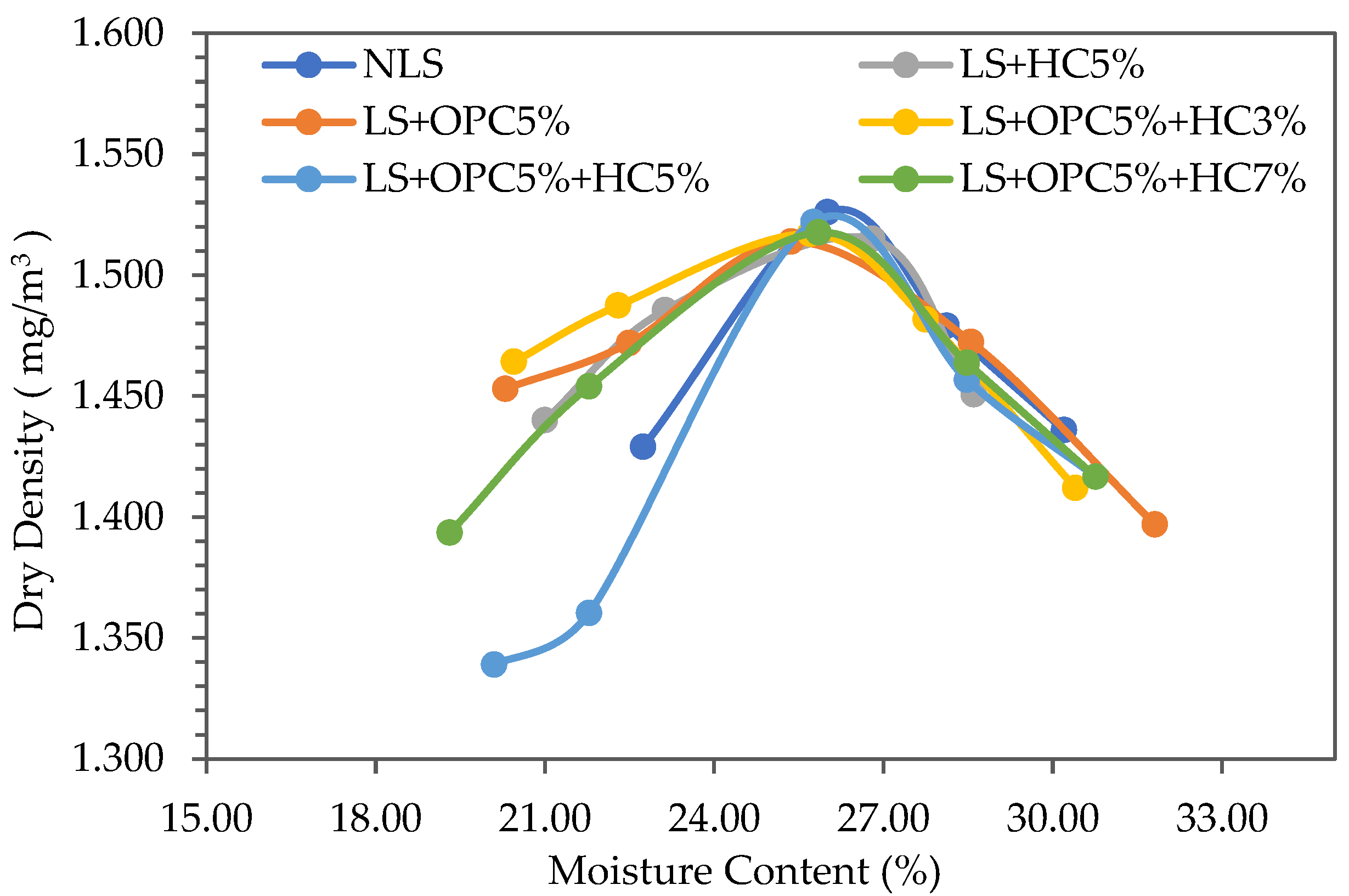
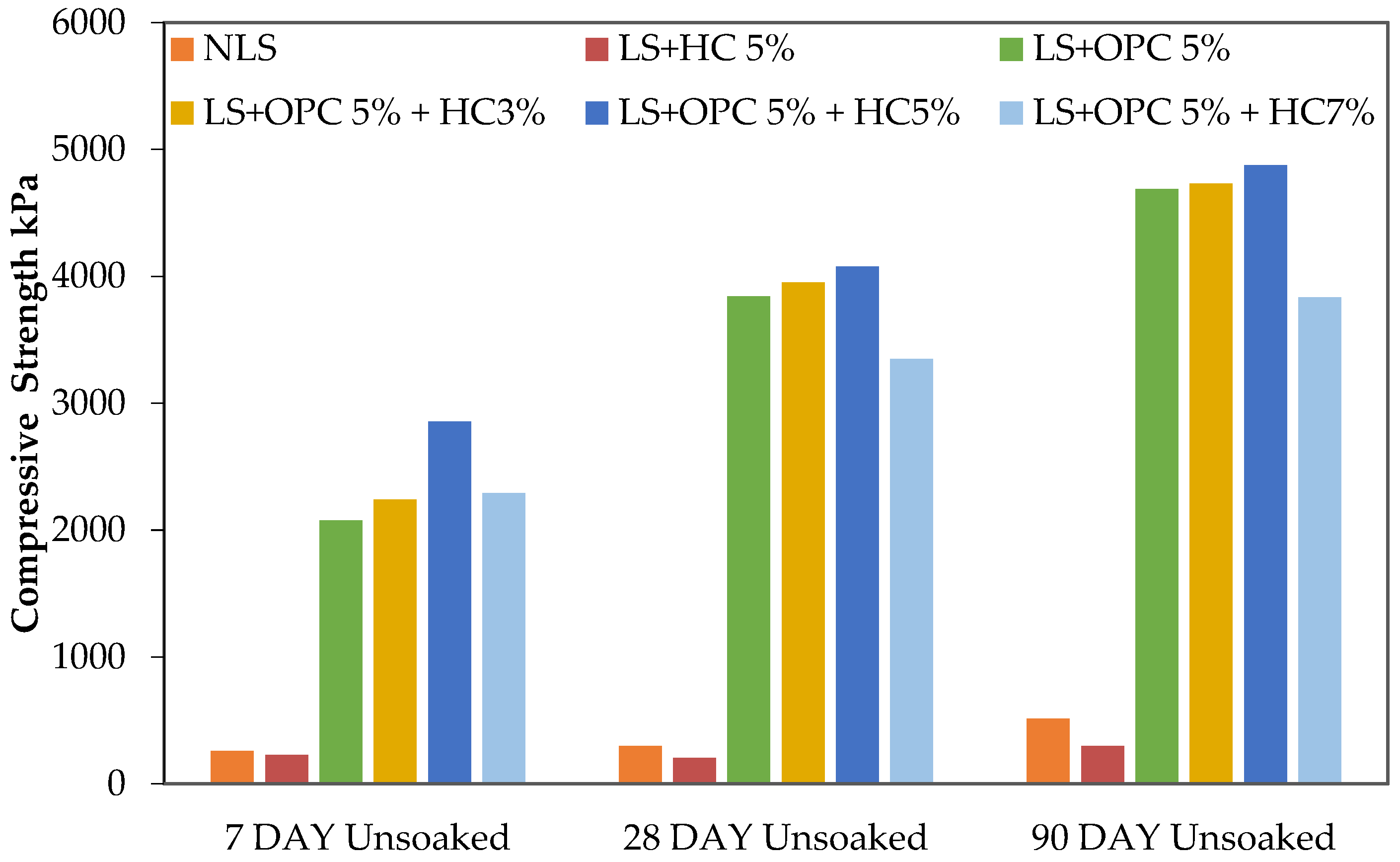

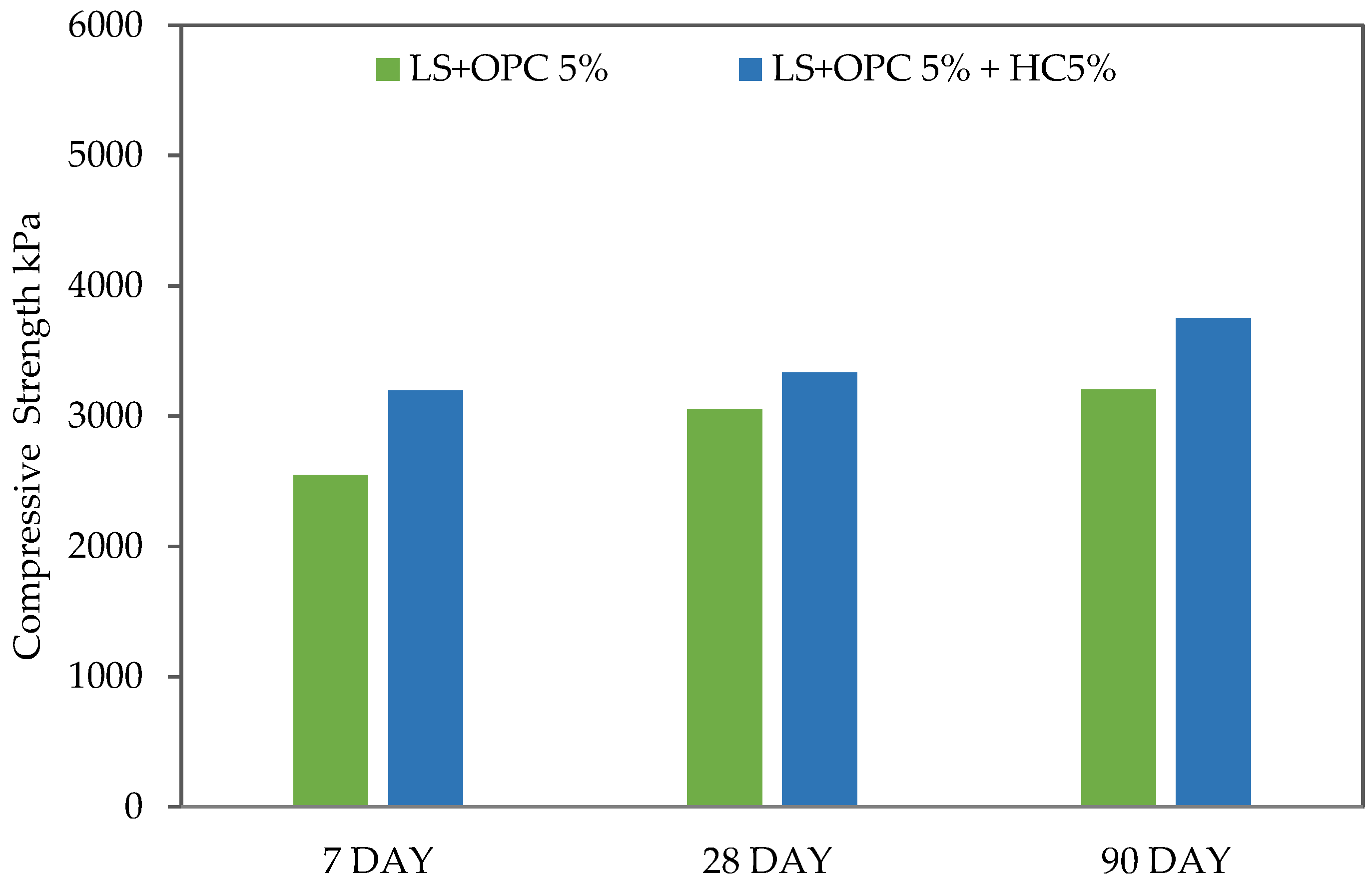
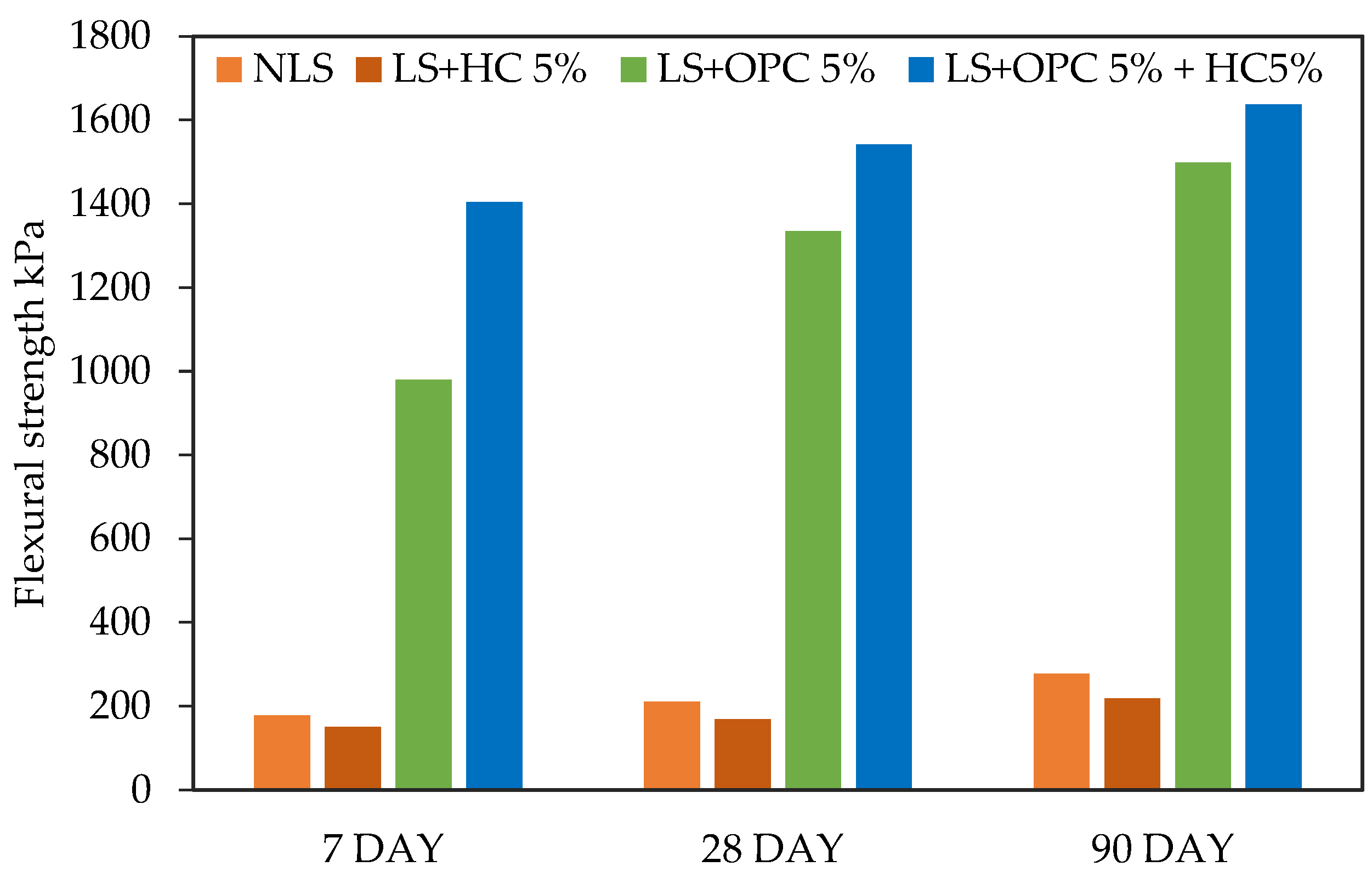
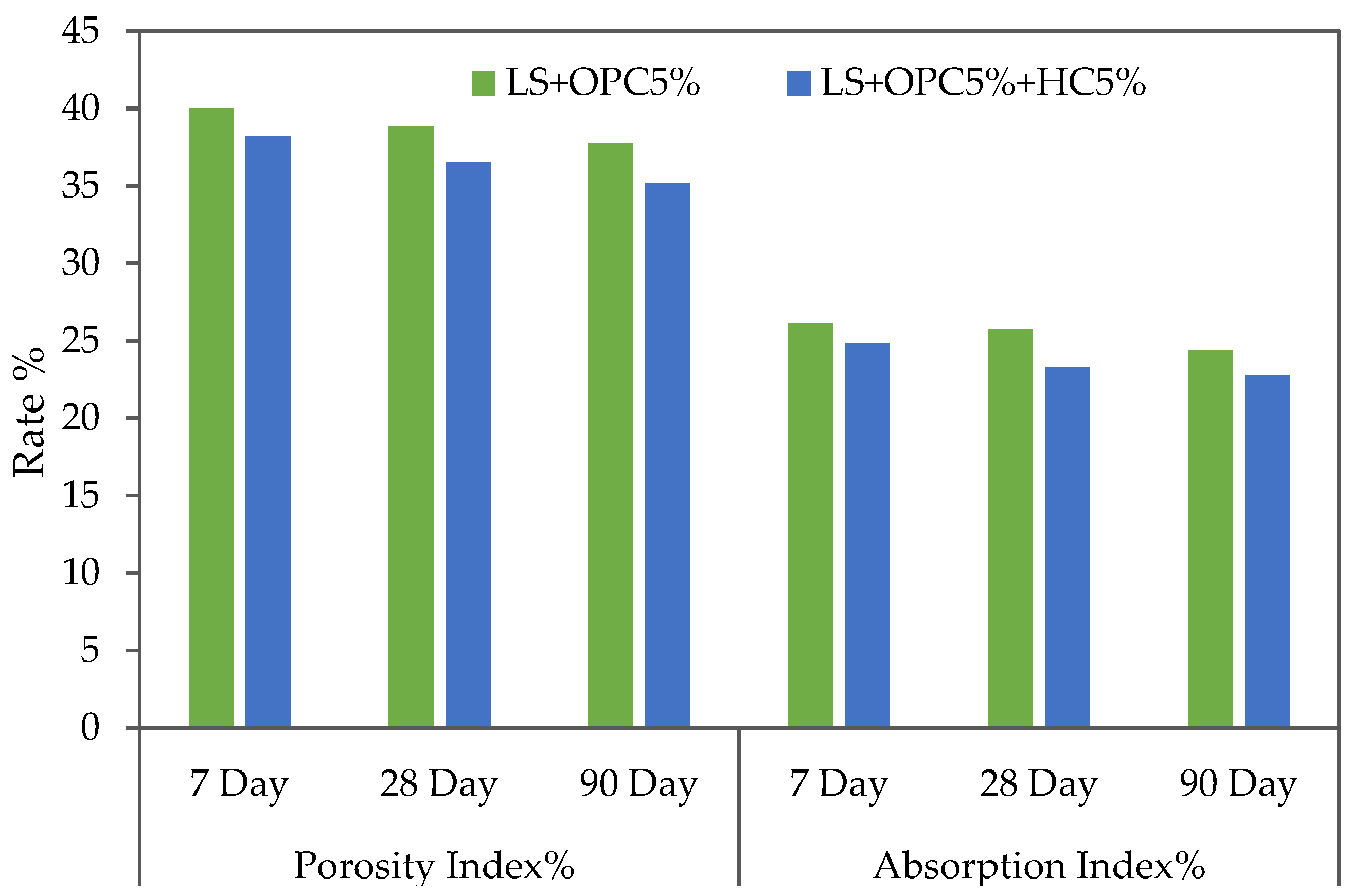
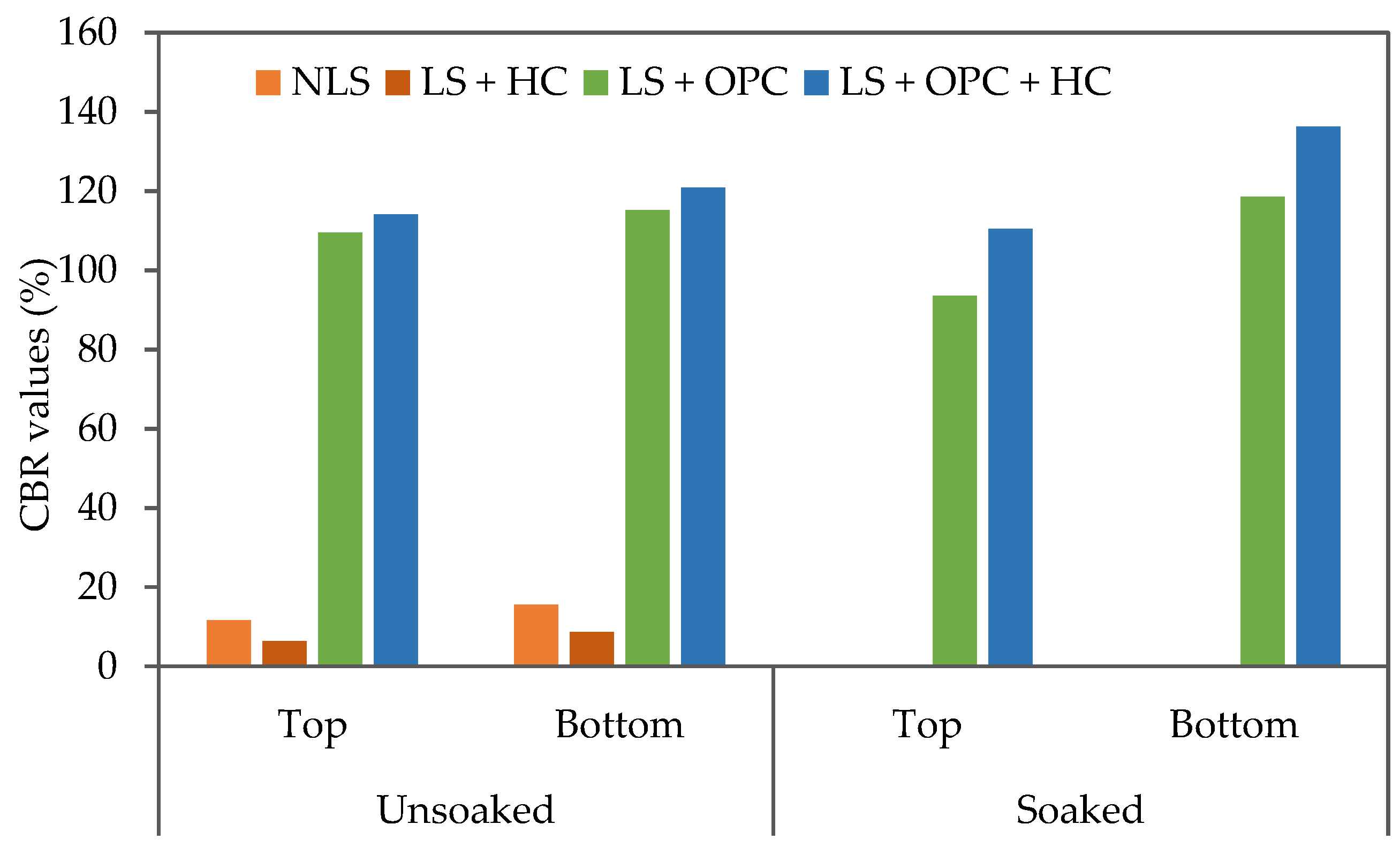

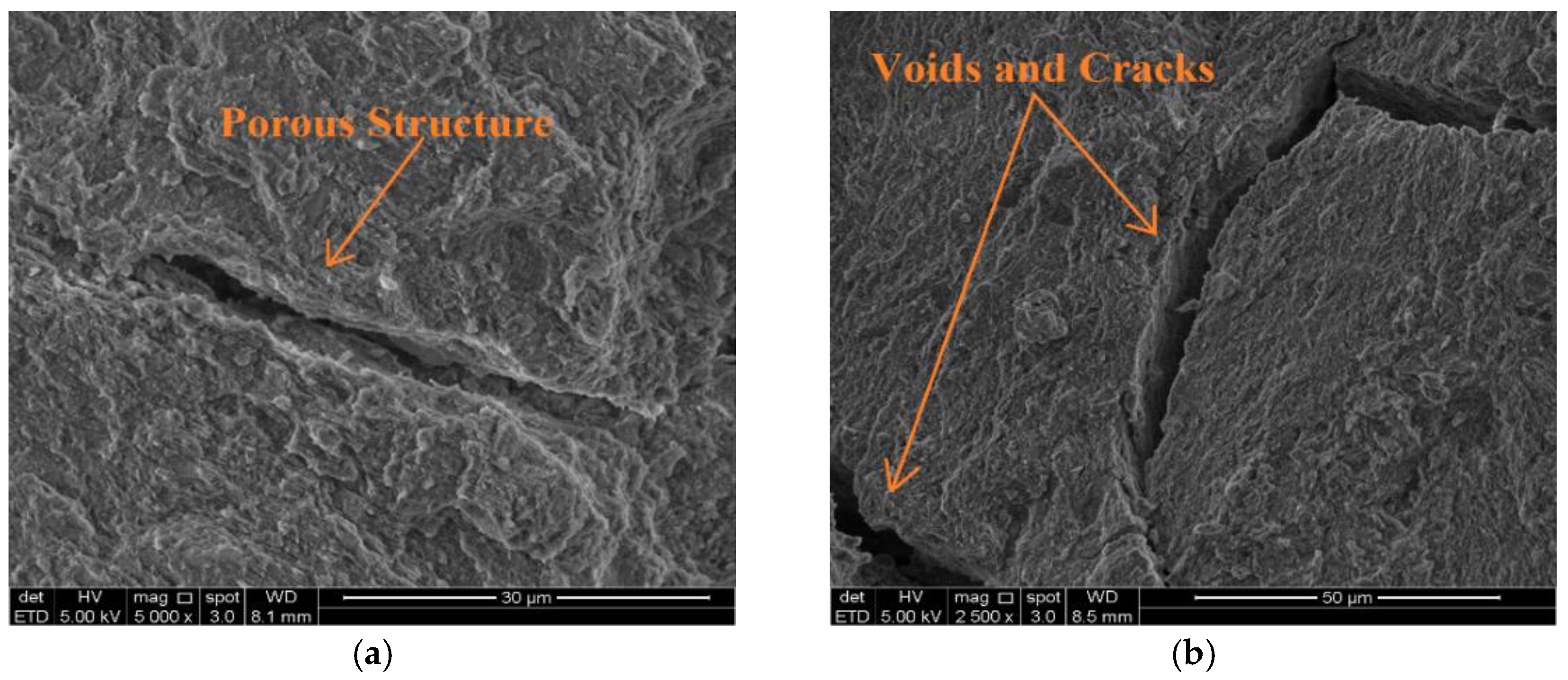

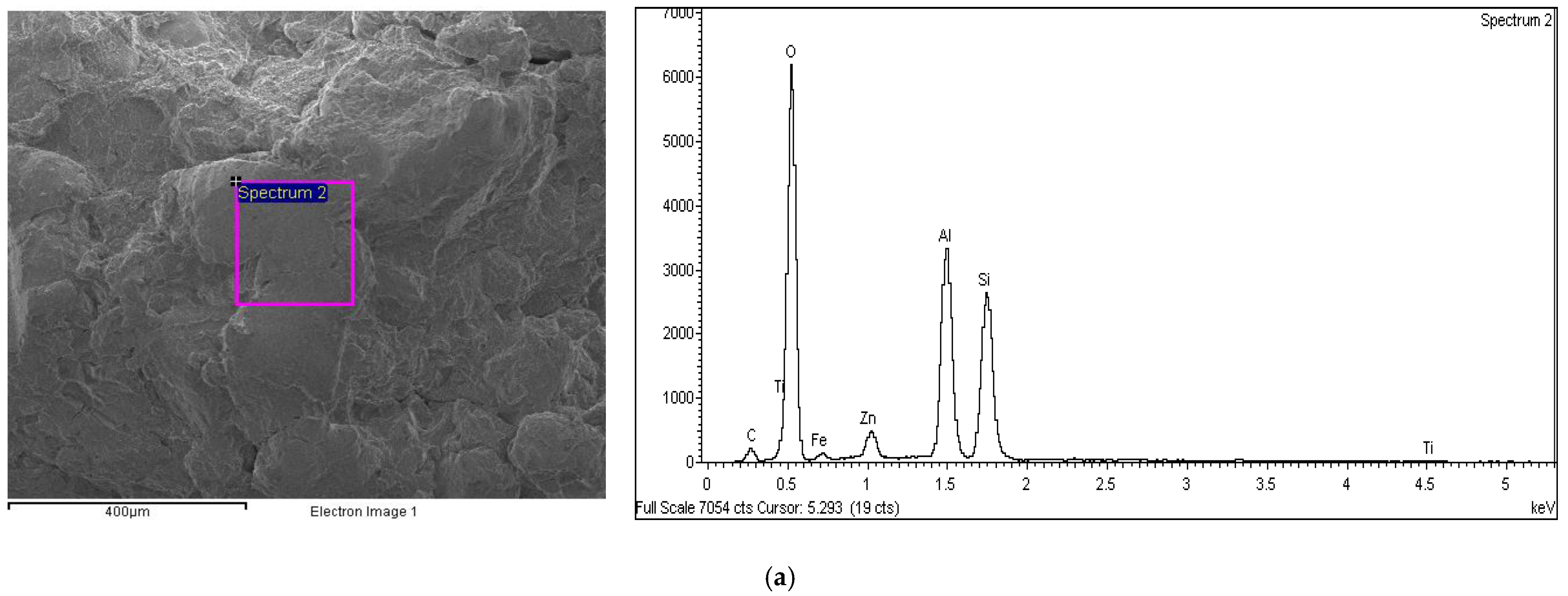
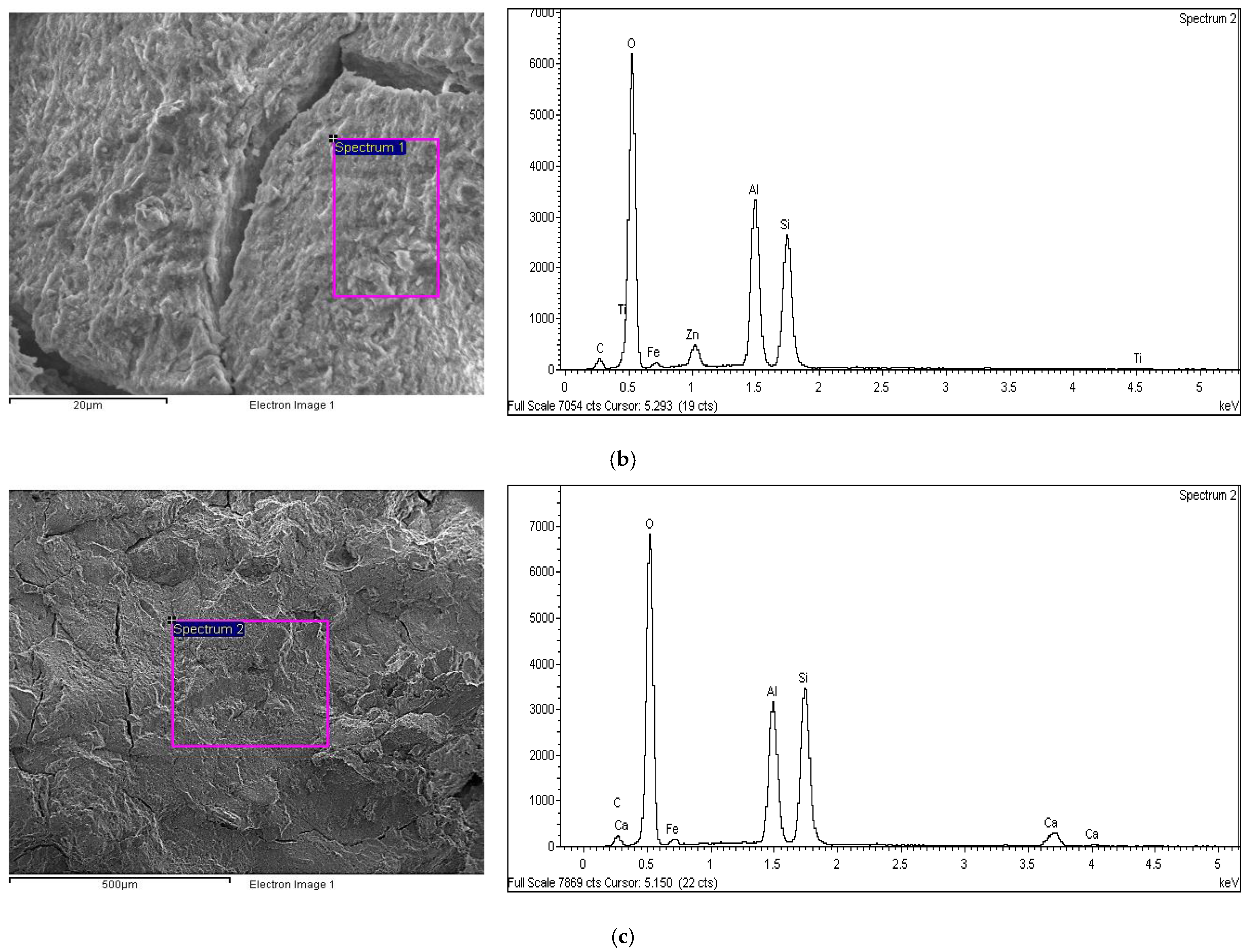
| Soil Properties | Quantity (%) |
|---|---|
| Specific gravity | 2.6 |
| Sand | 41.6 |
| Silt | 42.1 |
| Clay | 16.4 |
| * USCS classification | Silty sand (SM) |
| Liquid limit (LL) | 68 |
| Plastic limit (PL) | 45.7 |
| Plasticity index (PI) | 22.3 |
| Shrinkage limit (SL) | 10.8 |
| Optimal moisture | 24 |
| * Maximal dry density (mg/m3) | 1.5 |
| pH | 4.8 |
| Caltite properties | |
| Phase | Liquid |
| Specific gravity | 0.98 |
| Density (g/cm3) | 1.00 |
| Viscosity (m Pa s) | 1.5 |
| Color | Brown |
| pH | 10.2 |
| Cement (OPC) properties | |
| SiO2 | 21.8 |
| Al2O3 | 4.7 |
| Fe2O3 | 3.2 |
| CaO | 64.9 |
| MgO | 0.81 |
| P2O5 | 0.08 |
| K2O | 1.2 |
| Na2O | 0.09 |
| SO3 | 3.7 |
| TiO2 | 0.2 |
| Types of Soil | Mixture Design | Curing Period Days | Repetitive Sample | Test Name | Number of Samples |
|---|---|---|---|---|---|
| NLS | Natural lateritic soil | 7, 28, and 90 | 3 | UCS–FS | 18 |
| LS + OPC 5% | Lateritic soil with cement 5% | 7, 28, and 90 | 3 | UCS–FS–PA | 45 |
| LS + HC 5% | Lateritic soil with HC 5% | 7, 28, and 90 | 3 | UCS–FS–PA | 45 |
| LS + OPC 5% + HC 3%, 5%, 7%, and 10% | Lateritic soil with cement 5% and HC 3%, 5%, 7%, and 10% | 7, 28, and 90 | 3 | UCS–FS–PA | 63 |
| Total No. of Sample | 171 | ||||
| Sample No. | Soil NLS% | Caltite HC % | Cement OPC % | Curing Time Day | CBR % | ||||
|---|---|---|---|---|---|---|---|---|---|
| Unsoaked | Soaked | Average % | |||||||
| Top | Bottom | Top | Bottom | ||||||
| NLS | 100 | 0 | 0 | 7 | 11.62 | 15.56 | - | - | 13.59 |
| LS + HC | 100 | 5 | 0 | 7 | 6.41 | 8.69 | - | - | 7.55 |
| LS + OPC | 95 | 0 | 5 | 7 + 4 | 109.5 | 115.2 | 93.6 | 118.5 | 112.3–106 |
| LS + OPC + HC | 95 | 5 | 5 | 7 + 4 | 114.1 | 120.8 | 110.4 | 136.2 | 117.4–123.3 |
| Mixture | Curing Period (Days) | Element (wt%) | ||||||||
|---|---|---|---|---|---|---|---|---|---|---|
| Silicon (Si) | Aluminum (Al) | Calcium (Ca) | Iron (Fe) | Carbon (C) | Titanium (Ti) | Oxygen (O) | Ca/Si Si/Ca | Si/Al | ||
| NLS | 28 | 33.02 | 29.80 | – | 3.15 | 27.25 | 0.66 | 53.60 | – | 1.10 |
| LS + OPC 5% | 28 | 40.10 | 33.40 | 4.74 | 10.65 | 11.11 | – | 62.83 | 0.11 8.45 | 1.20 |
| LS + OPC 5% + HC 5% | 28 | 38.83 | 24.57 | 4.47 | 3.33 | 28.80 | – | 64.38 | 0.12 8.68 | 1.58 |
Publisher’s Note: MDPI stays neutral with regard to jurisdictional claims in published maps and institutional affiliations. |
© 2022 by the authors. Licensee MDPI, Basel, Switzerland. This article is an open access article distributed under the terms and conditions of the Creative Commons Attribution (CC BY) license (https://creativecommons.org/licenses/by/4.0/).
Share and Cite
Ezreig, A.M.A.; Mohamad Ismail, M.A.; Ehwailat, K.I.A. Hydrophobic Effect of Soil Stabilization for a Sustainable Subgrade Soil Improvement. Materials 2022, 15, 3087. https://doi.org/10.3390/ma15093087
Ezreig AMA, Mohamad Ismail MA, Ehwailat KIA. Hydrophobic Effect of Soil Stabilization for a Sustainable Subgrade Soil Improvement. Materials. 2022; 15(9):3087. https://doi.org/10.3390/ma15093087
Chicago/Turabian StyleEzreig, Ali Muftah Abdussalam, Mohd Ashraf Mohamad Ismail, and Khaled Ibrahim Azarroug Ehwailat. 2022. "Hydrophobic Effect of Soil Stabilization for a Sustainable Subgrade Soil Improvement" Materials 15, no. 9: 3087. https://doi.org/10.3390/ma15093087






